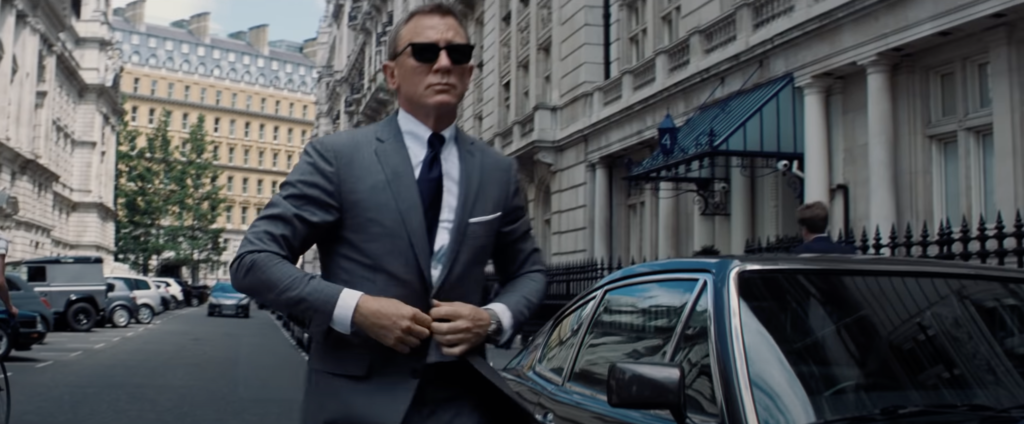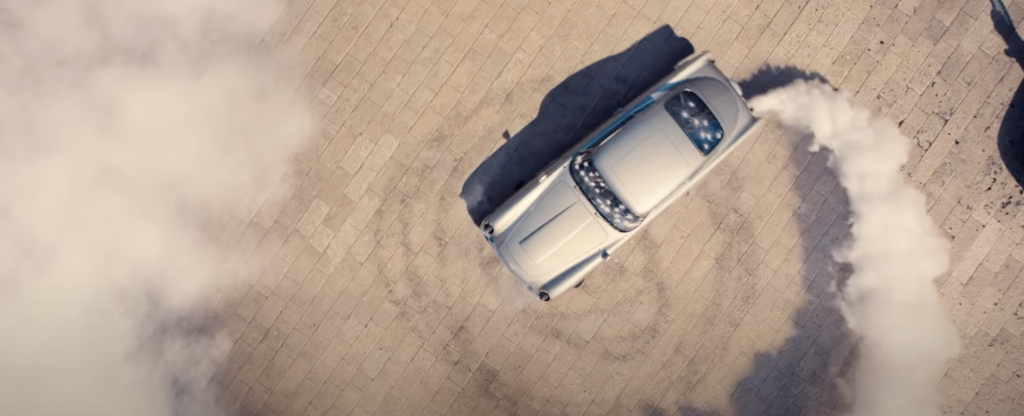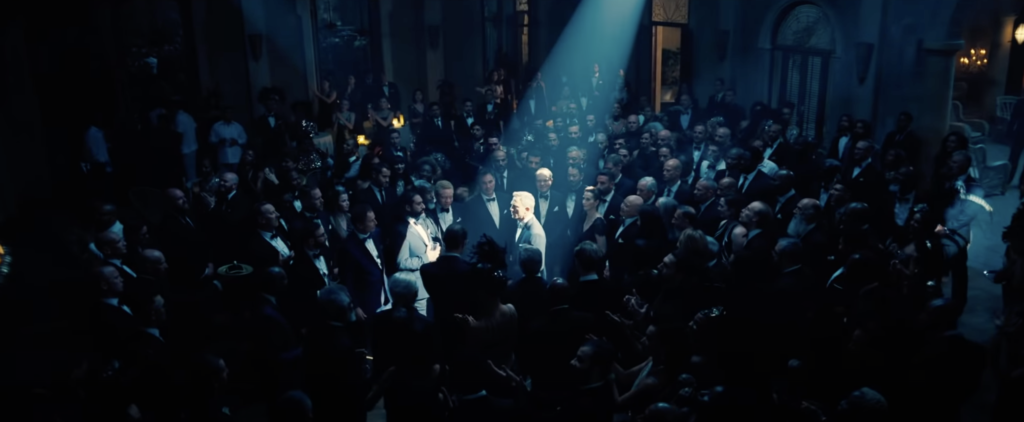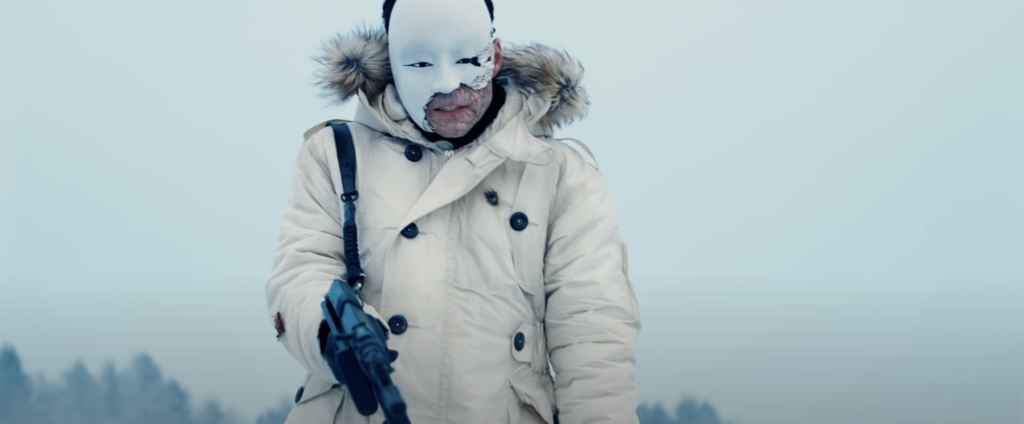
No Time to Die (Cary Joji Fukunaga, 2021)
(This review has very big spoilers for No Time to Die.)
No Time to Die is the 25th in the “official” Bond series started with Dr No in 1962; it is also the final in the Daniel Craig sequence that started in 2004 with Casino Royale. Because Casino Royale explicitly showed us Bond’s first mission, the Craig films established a distinct timeline from the rest of the series, which otherwise always had a loose, ambivalent approach to continuity. (Before this, it was kinda-sorta the same character and universe from film-to-film, even though that involved a stretchy approach to time and some blatant contradictions.) No Time to Die explicitly closes out this separate Craigverse; but it is in dialogue with the entirety of the series. While the film finishes with the customary “James Bond Will Return” subtitle, it would serve as an excellent capper to the venerable franchise. This is, in many senses at once, the ultimate Bond film.
It starts with urgent business resolving some hanging threads from its predecessor, Spectre, which involves the return of Lea Seydoux’s Madeleine Swan. At the end of Spectre Bond had left the secret service and departed with Swan, and No Time to Die picks up with the pair touring through Italy. It is similar to the way that Quantum of Solace followed straight on from Casino Royale, and means that the Craig era has an unusual 2-1-2 structure, with a stand-alone film (Skyfall) bracketed by a pair of two-part adventures.

Swan’s return – a first for the series, which has had recurring secondary characters but has never brought back a lead Bond woman – is the first of the film’s many successes. Swan’s character was one of the major failings of Spectre – she was set up as one of the great loves of Bond’s life, but unlike previous attempts at such a character (Diana Rigg’s Tracy in On Her Majesty’s Secret Service and Eva Green’s Vesper in Casino Royale) Spectre had failed to make this work. Yet No Time to Die is able to rehabilitate Swan before its opening titles, with its (admittedly lengthy) pre-title sequence both filling out her backstory and investing us in her relationship with Bond. It’s a tribute to script, performance and direction that the pre-title sequence does this so economically, while also serving up an effective horror movie pastiche and a thumping action sequence.
Those opening titles start with a pattern of dots that calls directly back to the series’ beginnings with Dr No, and continue with other imagery that recalls the titles of On Her Majesty’s Secret Service (over a subdued but haunting Billie Eilish song). These are two of my favourite films in the series, and it is interesting that they are key points of reference here. While Dr No provides mainly cosmetic inspiration – Ken Adams’ set design being a key reference for the design of the villain’s base, and there are rumours / fan theories that the villain here was initially intended to be a take on Dr No – On Her Majesty’s Secret Service is a key precedent for a Bond film with higher aspirations than is the norm for the series. Peter Hunt’s 1969 classic is probably the most ambitious film in the series to date in terms of its attempt to give dramatic and emotional weight to the story and Bond’s character. While I don’t have a problem with more straightforward Bond storytelling (my favourite Bond films include such no-frills Bond-on-a-mission films such as Tomorrow Never Dies, The Living Daylights, Goldfinger and the aforementioned Dr No), we know from Majesty’s and a few others in the series (most notably Casino Royale and Skyfall) that the character can be taken to more interesting places. No Time to Die is firmly within that small group of more ambitious Bond adventures, and I think it is even more successful than its predecessors.
That is partly down to craft and technique. The production values of the Bond series were drastically overhauled at the start of the Craig era, and even against that background this is a step up. Fukanaga’s direction is continuously inventive and enhances both action and exposition. The cinematography, by Linus Sandgren, does not quite have the same extravagant heights of Roger Deakins’ work on Skyfall, but I think shot-for-shot this is still the best-looking film in the series. The stunt and action work is outstanding, with all the action sequences effective in different ways. And while I still pine for the return of composer David Arnold to the series, Hans Zimmer’s score here is the best since the John Barry era. The score lays down an aggressive and distinctly Zimmer-esque foundation but then overlays variations on the Bond theme (plus some nods to Barry and Arnold’s work) as well as other influences such as Cuban rhythms. Together all these contributions help propel the film through its considerable runtime.

(Last spoiler warning!)
All this is in the service of a screenplay that makes some bold (and, it has to be said, divisive) choices. The least interesting version of the non-standard Bond film is the “rogue Bond out for revenge” story – this is what we got in Licence to Kill and what many mistakenly take the underrated, misunderstood Quantum of Solace to be. No Time to Die is not that; it is in fact pointedly the reverse, since MI6 don’t initially want his help and Bond actually ends up pushing to be brought back into the fold. But it goes further in making not one but a series of bold plot turns: killing Felix Leiter (a decision that has weight because in the Craig era the series finally gave us a proper recurring Felix, played by Jeffrey Wright); eliminating both SPECTRE and Blofeld (upending our assumptions about their status as the ultimate villains); giving James Bond a daughter (and perhaps more radically, showing a more everyday domestic side to his personality); and finally, having Bond sacrifice himself to save his family. It reminds me a lot of Rian Johnson’s The Last Jedi, which made similar unexpected departures in the Star Wars series, and pissed off a lot of people. Judging by my very scientific sampling of Bond fandom, three out of four Bond superfans were not keen on No Time to Die (though fortunately Bond fandom seems to have expressed this in a much more reasonable and less toxic manner than Star Wars fandom – why this is so is a topic worthy of study). But I like almost all of the decisions made here.
Some of these story choices are good simply for their surprising zig-instead-of-zag factor. Eliminating first the organisation of SPECTRE, and then Blofeld himself, halfway through is a great example. It’s also another way that the film manages to salvage the mess left by its predecessor. Spectre had thoroughly botched the return of Blofeld to the series, absurdly making him Bond’s adopted brother and leaving him belittled and imprisoned at film’s end. From this starting point, No Time to Die’s approach – almost completely ignoring the half-brother angle, and then using SPECTRE’s dispatch as a twist that enlarges our new villain – is an inspired choice that makes the best of a bad situation. It does cut against Bond history and tradition, but I think the Craig-era’s unique position as a carve-out from the rest of the series gives some license to try such things.
What’s also interesting about the elimination of SPECTRE is that the setup is a direct repeat of a scene from the earlier film – the gathering of villains that Bond is able to infiltrate. Yet where Spectre’s version of that scene was a gloomy and dull boardroom, here the meeting is dreamlike and grotesque, with bald waiters stalking the room as a robotic eye on a plate addresses the room. It shows the series learning the best lessons from Skyfall in layering some more fantastic elements back into the series. Where the first two Craig films had stripped the series back to something much closer to the grittiness of the Bourne series, No Time to Die gets the balance perfectly right by having a realistic centre – both in terms of some of the plot details, but also a psychologically grounded Bond – in creative tension with more bizarre and escapist elements. I think it has helped the later Craig films that their key competition is no longer the somewhat dour Bourne films but rather the more freewheeling Mission: Impossible series – this may have emboldened the producers to draw judiciously on the more over-the-top elements of the series’ legacy.

The elimination of SPECTRE occurs during the film’s stretch in Cuba, and I think even many of the film’s detractors love this portion of the film, which builds to a rousing fight in and around the venue housing the SPECTRE conference. Bond fights alongside agent Paloma, played by Ana de Armas – who it must be said is outrageously over-qualified for her tiny role. In earlier Bond films this character would have been either a sexual conquest for Bond, or a sacrificial lamb killed off to raise the stakes. (Or both.) The film plays with both expectations, but reverses them with Paloma surviving, excelling in her mission, and not sleeping with Bond. (It is clear, incidentally, that the latter point does not come from any prudish or moralistic place – it is also strongly hinted that she might have been up for something with Bond if he had stayed longer.) The use of the character is a breath of fresh air for a series that as recently as Skyfall had struggled with its treatment of secondary female characters.
Given this, one might note that the credited screenwriters include Phoebe Waller-Bridge (alongside the director Cary Joji Fukunaga, and series regulars Neal Purvis and Robert Wade). She isn’t the first woman with a screenplay credit on the series, but it has been a long gap (Johanna Harwood was credited on Dr No and From Russia with Love, the first two films in the series). I would also argue that she is the most accomplished screenwriter to work on the franchise, on the strength of her sublime TV series Fleabag alone. It would be unfair to the other screenwriters to credit everything I like to Waller-Bridge’s involvement – and it must be said that there has been improvement, including with regards to treatment of women, in the scripts to which Purvis and Wade have contributed over their tenure – but whoever deserves credit, certainly there is a degree of emotional intelligence to the writing here that is beyond the series’ norms.
Look, for example, at the treatment of Loshana Lynch’s Nomi, who has inherited Bond’s title of 007. There is a much less interesting version of this film where antagonism between Bond and Nomi is resolved with a last-act recognition by Nomi of our hero’s awesomeness. At first glance that seems to be the case; but actually the trajectory is a smarter and more satisfying mutual appreciation. Before the film’s conclusion, when Swan and her daughter Mathilde have been kidnapped, there is a lovely small moment where Nomi insists she is going with Bond on his rescue mission. It is his tired but appreciative “thank you, 007” – signalling not only his recognition of her skills and legitimacy as the new 007, but also his fears that he cannot save Swan and Mathilde alone – that is the crucial step in their accord.
Small moments like this are important because throughout No Time to Die we have an older and more mature (in every sense) Bond than we saw in the previous Craig films. I have seen suggestions that by revisiting Bond’s hang-ups about Vesper Lynd in the pre-title sequence, No Time to Die is backing over the territory of Quantum of Solace. But I think this fails to recognise the difference in Bond himself. In Casino Royale, M tells Bond that he needs to learn who to trust; although once he has learned that lesson, she also offers the human comfort that Vesper gave her life to save his. In Quantum of Solace Bond is out for answers (not revenge!) and learns that M was right. At the film’s conclusion his loyalty to M is affirmed and we get the sense Bond can now forgive Vesper. At the start of No Time to Die Bond has moved on from the service but, as Swan notes, is continuing to look over his shoulder. The lack of trust that hangs over from his espionage days is clearly a hindrance to him properly enjoying a normal life, including his relationship with Swan; but it is clear Bond wants to do so. And when he visits Vesper’s grave, what he says is “I miss you,” and the note to Vesper that he burns reads “forgive me.” Both sentiments are quite distinct from where he was at either start or end of Quantum of Solace. His focus has turned to first, the qualities he loved in Vesper; and second, blaming himself for her fate, rather than dwelling on what she did to him. When Bond thinks he has been betrayed by Swan, it is a setback to this emotional progress that the balance of No Time to Die then sees him work through. So while Bond is still dealing with the fallout from Vesper’s betrayal, this is definitely new ground for Bond.
After the pre-title sequence we see Bond now alone in retirement, in a sequence that parallels early scenes in Skyfall. In that film, though, Bond was full of angst and resentment. Here he is clearly enjoying his life after MI6, even if it is also quickly made clear that part of him misses his old work. As the story progresses, and Bond is reintroduced to Madeleine Swan, his emotional journey is built on his regret at too readily assuming she betrayed him, and the challenge of integrating into his newfound family unit. While for some this is territory that may feel beyond the realm of a Bond adventure, I enjoyed the new angles this wiser Bond brought. I also think that Skyfall forced the series’ hand in many respects: because that film essentially fast-forwarded to a late-career Bond, a more standard take on Bond would have felt like backsliding.
(A related aside: I have seen criticisms of the films main villain – Rami Malek’s Safin, particularly in terms of his motivation and some details of his plan. There are some gaps in this respect, although I think they are not especially important and easily inferred from the material we do get. However this is where the film’s emphasis on character development shines through. Safin might lack some classic motivations in a strict causal sense, but the film is more interested in his psychological landscape. His emotionally stunted, possessive attitude is all-too-familiar and works in effective counterpoint to the more mature, outward-focussed Bond of this film.)

The character-based focus also enhances the film’s already impressive action sequences. In the pre-title sequence, for example, the moment where SPECTRE goons try to break through the windshield of Bond’s car is far more agonising because Bond seems so unwilling to respond to Swan’s anguished pleas. Later, a chase in Norway is intensified by the fact that Bond has Madeleine’s daughter in his car. Where too many Bond films have tried to liven up action with gimmicks, No Time to Die understands that the best way to enliven action scenes is to give them strong character stakes. Some may also feel that certain moments, such as those drawing on our established investment in a character such as Jeffrey Wright’s Felix Leiter, are cashing cheques written by other films. But isn’t that exactly what a film like this should do? What is the point of a 25th entry in a longstanding series if it cannot leverage off our investment in recurring characters? Frankly, it’s an indictment on the series that it has done this so rarely.
Of course, No Time to Die is not just leveraging off the Craig continuity that dates back to Casino Royale – it is also drawing on the rest of the series’ history. I have already mentioned the nods to Dr No end On Her Majesty’s Secret Service, and the film’s ties to the latter are especially clear. Early references in both dialogue and score to Bond and Tracy’s refrain of “we have all the time in the world” signal that another great tragedy in Bond’s life is on the way. What No Time to Die does so effectively is to subvert the normal approach of both the series and the genre, which would see a moment of loss primarily in terms of its impact upon our hero. I have already referred to the problematic approach often applied to supporting women in the series, too-often dispatched to provide weight to Bond’s mission. Even those characters such as Tracy and Vesper, who are provided more individuality and agency, ultimately serve as moment’s in Bond’s story (Tracy as a great love loss; Vesper as a more problematic symbol of both love and betrayal).
No Time to Die flips this approach, and in so doing shines new light on tropes that have run through the series. In Goldeneye the villain says to Bond:
Oh, please James, Spare me the Freud. I might as well ask you if all the vodka martinis ever silenced the screams of all the men you’ve killed – or if you find forgiveness in the arms of all those willing women, for all the dead ones you failed to protect.
It’s the kind of line the series would often drop in to add a superficial sense that Bond has a depth beyond his unflappable veneer. Yet it was rarely taken much further, and the casual dispatching of secondary female supporting characters in the series was often at odds with the purported interest in such questions. By showing Bond actually willing to die to protect the women in his life, No Time to Die is taking this thematic thread and treating it with a seriousness the series hadn’t been willing to entertain before.
So while some feel the films’ conclusion is a betrayal of the Bond formula, to me it feels a perfect counterpoint not just to the story of Bond’s failure to save Vesper in Casino Royale, but also to tropes weaved deeply through the fabric of the series. I know the ending has infuriated some, but I found it fulfilling and a worthy and earned conclusion – much as, in 1969, the ending of On Her Majesty’s Secret Service was at once an affront but also the fitting end to that film’s story.
For my ranking of all the films in the series, written alongside this review, click here.